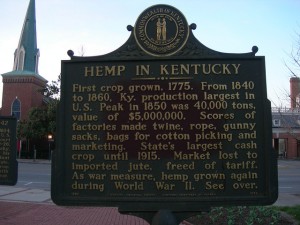 Industrial hemp has had a long, fruitful, and interesting history. It has been used for over 10,000 years as food, medicine, clothing, fuel, and in construction.
Industrial hemp has had a long, fruitful, and interesting history. It has been used for over 10,000 years as food, medicine, clothing, fuel, and in construction.
It is now classified as a schedule 1 drug under the Controlled Substances Act – a move that made it illegal to grow without a permit from the DEA.
It is amazing (or, perhaps a better word would be disturbing) that this wondrous, healthy plant was made illegal so investors in oil, chemicals, pharma, and timber could reap their benefits at the expense of our health and the health of our planet.
The chemical, drug, oil, and timber industries have taken their toll. Our nation is an industrialized nation, which means we consume huge amounts of oil, gas, chemicals, additives in foods, chemical drugs to treat every illness under the sun. We’ve become a nation addicted to ‘fast, quick, easy’. But that system isn’t always healthy.
Our fast foods, canned foods, and prepared foods are laden with chemicals. We have gone from fresh, farm or home-grown to over-processed nutrient-deficient foods.
Our illnesses are treated with chemical drugs, most of which have warnings because they, themselves, are dangerous. Have you looked lately at the side effects of most chemical meds? If you take a close look, you will realize that these are what are making us sicker and even killing us. (Now, I am not saying all meds are bad, and yes, some people do need to be on meds for health or stabilization.) Hemp can (and does) treat many illnesses and disease. If we look at the causes of disease, we will find that many are the cause of emotional or nutritional imbalance. And how can we best treat disease and illness? Nutrition. And what is one of the most nutritional plants around? Yes, you guessed it. Hemp.
We have become dependent on oil. Look at this, though. Oil and fuel processing in itself is unhealthy for the environment (and humans). Oil extraction can be as well. (See: Gulf of Mexico) And the alternative? Hemp fuel! Hemp fuel is safe, clean, and non-toxic. If it spills it acts more like a fertilizer than a health hazard. Henry Ford’s idea to build hemp cars and use hemp fuel (he grew his own hemp) was an excellent option.
Many of the substances we use today are petroleum based or synthetic (chemical based) – plastics, nylon to name a couple. Anything that can be made from fossil fuels/oil can be made from hemp.
William Randolph Hearst (yes, the newspaper guy) had a huge stake in timber and owned a couple sawmills. He was one of the main supporters of banning the use of hemp. Why? It was a threat to his timber investments. Did you know that The Declaration of Independence was made with hemp? Paper products made from timber are very chemical intensive. Writing paper, paper bags, napkins, toilet paper, paper towels, books – all of these have been processed with chlorine and numerous other chemicals. Yes, paper from trees can be recycled; yet the chemicals in them remain. Do you know, even recycled toilet paper has chemical residue from the paper it was recycled from? Hemp paper is stronger, lasts longer, and is processed easily and with less toxic chemicals.
Hemp does not need pesticides or herbicides. It does that naturally. Hemp uses less water than cotton. (Did you know, cotton growth/manufacturing uses HUGE amounts of water and chemicals – cotton is one of the most chemical intensive crops.) Hemp heals the soil and cleans the air. It is healthy – for body, environment, and economy.
Now, this is where the change must occur. Yes, in the 1930s there was change – our country went from being one that embraced hemp and all it’s greatness to one that shunned it in favor of unhealthy alternatives, thanks to lobbyists for the big oil, chemical, pharma, and timber investors.
It is time to change once again, BACK to the plant that will help our planet, our health, and our economy. There will be people kicking and screaming. There were (and are) those who will fight hard and dirty to keep hemp illegal. They do not want their investments threatened. However, CHANGE is needed.
The propaganda about hemp needs to be dispelled. Ideas need to change; minds need to embrace the idea that yes, hemp IS a good thing. For some, change is a scary thing.
There have been families, for generations, whose livelihoods have depended on the oil and timber industries. In some areas those were the main industries. These people worked hard to feed their families and send their kids to college, to build their lives. I am not bashing those who worked, sweated, and died working to care for their families, especially those in the timber industry. I’ve been touched first-hand by that. My ex-husband’s brother died working for a logging company. I have other friends who were injured badly or disabled in that industry. I am NOT saying that the timber industry is all evil. We need wood for construction, etc.
What I AM saying, though, is that there are some products that can be replaced with hemp – paper, for example – simply because hemp is the better, cleaner, healthier alternative. We DO need to reduce the amount of trees that we use. They take 20-40 years to grow. Hemp, however, takes months and can produce much more per acre than trees.
Yes, change can be scary. Going back to hemp is a good change – healthier earth, healthier bodies, healthier air, healthier environment. But, in order to evolve, to GROW, we must EMBRACE that change…
One hempseed at a time.










